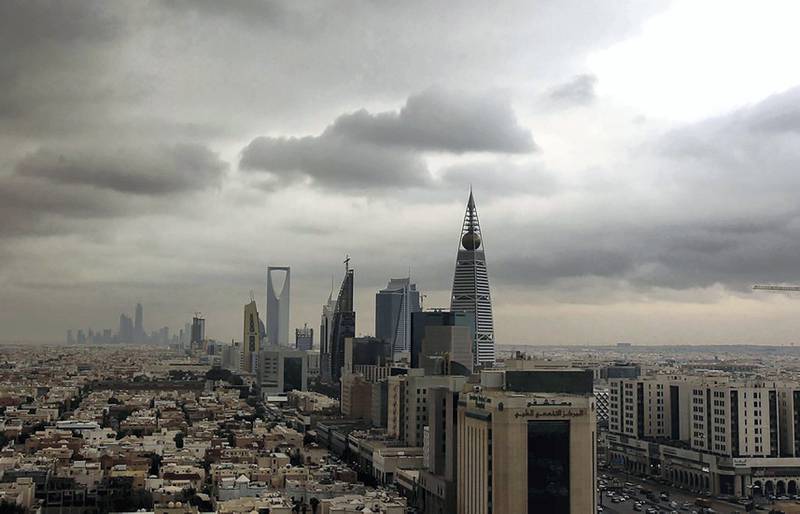 The Riyadh skyline. Saudi Arabia's economy is forecast to grow 8.3 per cent in 2022, a World Bank report has said. Reuters
The Riyadh skyline. Saudi Arabia's economy is forecast to grow 8.3 per cent in 2022, a World Bank report has said. Reuters
GCC economies are projected to grow 6.9 per cent in 2022 before moderating to 3.7 per cent and 2.4 per cent in 2023 and 2024, respectively, driven by stronger hydrocarbon and non-hydrocarbon industries, the World Bank has said.
The easing of coronavirus-induced movement and social restrictions, and positive developments in the hydrocarbon market drove strong recoveries in 2021 and 2022 across the six-member economic bloc, the Washington-based lender said in its Gulf Economic Update report released on Monday.
The increase in oil and gas prices, exacerbated by the war in Ukraine, is estimated to provide a windfall for the GCC, it said.
“There is an excellent and timely opportunity to diversify the economy further using a green-growth strategy and play a leading role in the global transition to low-carbon economies,” said Issam Abousleiman, World Bank regional director for the GCC.
“The region could use the green-growth transition to focus policies on developing green technologies and associated skilled labour that would reverse trends in productivity and enable the region to grow faster.”
The International Monetary Fund cut its global growth forecast for 2023 and warned of a cost-of-living crisis as the world's economy continues to be affected by the war in Ukraine, broadening inflation pressures and a slowdown in China.
The fund maintained its global economic estimate for this year at 3.2 per cent but downgraded next year’s forecast to 2.7 per cent — 0.2 percentage points lower than the July forecast.
Middle East and Central Asia economies are forecast to grow 5 per cent this year before decelerating to 3.6 per cent in 2023, after expanding 4.5 per cent in 2021, the fund said earlier this month.
Total economic output of the GCC countries is projected to be about $2 trillion in 2022, according to the World Bank.
If the Gulf countries continue business as usual, the region’s combined gross domestic product will grow to $6tn by 2050, it said.
That figure could shoot up to more than $13tn by 2050 if Gulf countries adopt a green-growth strategy that accelerates economic diversification, the lender said.
“Supported by higher hydrocarbon prices, the GCC region is expected to register strong twin surpluses in 2022 and over the medium term,” the World Bank report said.
“The regional fiscal balance is projected to register a surplus of 5.3 per cent of GDP in 2022 — the first surplus since 2014 — while the external balance surplus is expected to reach 17.2 per cent of GDP.”
It is "critical" to invest the oil windfall in the GCC’s economic and environmental transition and increase the share of the private sector in investment and job creation, the World Bank said.
However, a reduction in oil output would not only raise the risk of slower economic growth but might also shrink the anticipated fiscal and external surpluses in the near-term, the lender warned.
Inflation is expected to pick up in 2022 in most GCC countries but remains much lower compared with other regions.
“After a period of low inflation and bouts of deflation, inflation is projected to reach 3.3 per cent during 2022 before moderating to 2.5 per cent in the medium term,” the report said.
Saudi Arabia, the Arab world’s largest economy, is forecast to grow 8.3 per cent in 2022 before moderating to 3.7 per cent and 2.3 per cent in 2023 and 2024, respectively.
The oil sector will remain the main driver behind the kingdom’s economic growth.
The UAE, the Arab world’s second-largest economy, is estimated to grow 5.9 per cent in 2022 before moderating to 4.1 per cent in 2023 as slower global demand dampens expansion due to tightening financial conditions, according to the World Bank.
“Higher oil export volumes coupled with a revival in non-oil demand will support strong economic growth in 2022. This is further supported by a favourable business environment and world-class infrastructure [in the UAE],” the bank said.
Kuwait’s economic growth is forecast to accelerate to 8.5 per cent in 2022 before slowing to an average of 2.5 per cent in 2023 and 2024.
Qatar is forecast to grow 4 per cent this year on the back of a stronger hydrocarbon sector and the strengthening of the tourism sector as the country hosts the Fifa World Cup, which begins on November 20.
Bahrain’s growth is expected to improve to 3.8 per cent in 2022, mainly driven by the non-hydrocarbon sector, the full reopening of the economy and a more robust manufacturing sector.
Oman’s GDP growth is forecast to reach 4.5 per cent in 2022 before moderating to an average of 3.2 per cent in 2023 to 2024.
The economy’s recovery will be driven by energy prices, the expansion of oil and gas production and structural reforms, the World Bank said.
